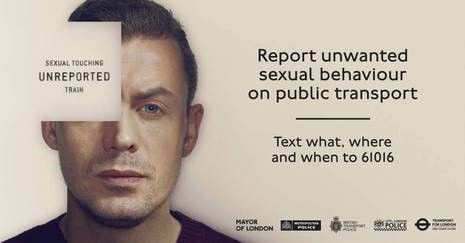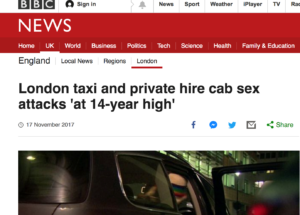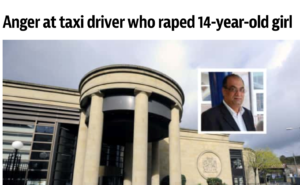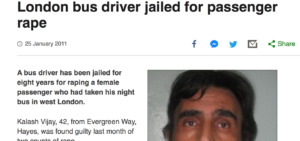Multiculturalism, Feminism, and the Transport Rape Epidemic

“There have been rises in reported sexual offences on London Underground and London Overground networks.” Transport for London, 2017/2018 Crime Statistics Bulletin.
“The number of rapes and sex assaults of taxi and private hire passengers in London reached a 14-year high in 2016.” BBC News.
One of my all-time favorite thrillers is Richard Harmon’s claustrophobic The Hitcher (1986). Its premise is superficially simple. A young man, Jim Halsey, is in the process of delivering a car from Chicago to San Diego when he unwittingly stops to pick up a psychopathic hitchhiker, John Ryder, who is in the midst of a murder spree. The film, as it then swiftly unfolds, is essentially a single chase sequence as Halsey attempts to escape Ryder’s obsessive and maniacal attentions and avoid becoming the latest of his victims. The film was released to great critical acclaim in Europe, where it won the Critics Award, Grand Prix, and the TF1 Special Award at the 1986 Cognac Festival du Film Policier. It was less well received in the United States due to the extremity of its rarely depicted, but often suggested, violence. Along with Rutger Hauer’s magnificent performance as the enigmatic Ryder, the overall success of the film probably resided in the way in which it subverted cherished notions about modern transport, and about the car in particular. Much of modern ‘car culture’ and associated marketing orbits an often dubious and self-contradictory rhetoric of freedom, sex, speed, escapism, youth, individualism, ostentation, and safety. Rebuking this rhetoric, The Hitcher portrays the car itself as a kind of lethal trap; a means of imprisonment in one sense, and hostile pursuit in another.
In stopping to pick up Ryder, Halsey operates on a series of assumptions later shown to be disastrously false — the most important being the assumption that being a driver provides one with situational control, and that inviting a total stranger into a confined and solitary space is both sensible and morally right. Ryder is standing in torrential rain when the altruistic Halsey stops for him out of pity. What Halsey does not know is that Ryder has just finished dismembering the last driver who stopped for him. Halsey’s potentially fatal altruistic assumptions are underscored by the film’s opening line (Halsey to Ryder: “My mother told me never to do this”) as occurring amidst a conflict of personal instinct/folk wisdom/common sense (symbolized by the maternal advice) and broader societal expectations such as taking pity on strangers and assuming the best of their nature and intentions. In conforming to the latter, Halsey plunges himself into an odyssey of escalating horror. Original aspects of the film, which stood in contrast with real-life developments, included the choice to make the hitchhiker perform the role of murderer, and for the pursed victim to be male. In reality, the context of 1970s and 1980s America (and indeed other Western nations) witnessed innumerable hitchhikers, almost exclusively young women, become the victims of driver-murderers. Many such incidents, such as the Santa Rosa hitchhiker murders, remain unsolved. The overlap between the movie and the real-life criminal context may, however, be regarded as concerning the same basic fatal (and quite modern) assumptions — both in terms of the nature of the car and transport, and in terms of broad social expectations concerning conduct in relation to strangers.
It’s axiomatic of most cultures that children are cautioned against speaking to strangers. Unfortunately, our culture has succumbed to the lazy notion that once a young woman reaches the age of eighteen she is suddenly and magically capable of fully ‘adult’ thought and is, moreover, almost invulnerable. By the 1990s, Second and Third Wave feminism, blended with the most inane aspects of pop culture, resulted in the ludicrous meme of “Girl Power,” an entirely imagined social faculty which paved the way for female binge drinking and new heights of often irredeemably harmful sexual adventurism. This relatively new phenomena, and the rise of the club and rave scenes, necessitated an increase in the nocturnal use of urban public transport and private cab hire by the young female demographic. Feminism dictated that young women had both the ‘right’ and the ability to use such transport, without hindrance, as an expression of independence, autonomy, and female empowerment. Such thinking made a significant contribution to the erosion of what one feminist academic called “the geography of women’s fear” — what might more bluntly be described by non-feminists as the abandonment of common sense. Fatefully, this development coincided with a peak in mass migration to the West from the Third World, and from the Indian sub-continent in particular. Many of these immigrants, when they worked at all, drifted into the ranks of unskilled labor, gravitating heavily towards cab driving.
For the most part segregated within ethnic enclaves, cab driving offered many of these immigrants, often with the crudest mentalities and most primitive intellectual and cultural attainments, their only access to White women. Thus, an increasing number of vehicles involved in the new urban nightlife became both actual and representative meeting places of multiculturalism, feminism, and modernity. Symptomatic of the pervasive sickness in our civilization, the great majority of people thought nothing of countless inebriated young girls getting into vehicles with drivers of foreign blood and from foreign cultures where rape is pandemic. In most cases, the saturation of multicultural dogma was such that these girls couldn’t even fall back upon the fabled advice of Jim Halsey’s mother. Instead, day after day, and night after night, they cheerfully, naively, and voluntarily confined themselves into small, solitary spaces with men born in far distant lands, pulling the door shut behind them and thus enclosing themselves in their own personal odyssey of terror. The result of these numerous cultural (and multicultural) failings has been a public transport rape epidemic that has reached acute levels in London, but which embraces most of Britain and indeed much of the West.
Most news headlines are generic enough that one might miss the ethnic dimension to the unfolding rape epidemic on Western public transport and cab hire. In 2016 the New York Post reported that statistics showed “New York women have a much greater chance of being sexually assaulted in a taxi than even in the darkest, dirtiest corners of the subway system.” The same year, The Independent reported that between 2011 and 2016 more than 1,400 cab drivers in London had been charged with crimes, and that 2015 had witnessed a rise in charges for “assault, grievous bodily harm, indecent exposure and rape.” A year later the BBC reported that “the number of rapes and sex assaults of taxi and private hire passengers in London reached a 14-year high.” Another media outlet reported that between 2014 and 2017, “two South Yorkshire taxi drivers have been accused of rape, 15 have been accused of sexually assaulting women and three others have been accused of sex attacks on men.” One London judge went on record as saying that “no woman was safe in a minicab.” Meanwhile, the West Australian Department of Transport issued figures showing a 30% rise in cab drivers facing charges for “rape, drug dealing, and assault.” But who are these rapists?

If you asked the average Briton to name a taxi cab rapist they would likely respond with the name of John Worboys, the White Englishman convicted in 2009 of attacking 12 victims and suspected of attacking up to 100. My own opinion on Worboys is that he should be taken from the comfort of his prison cell and subjected to an incredibly painful but imaginative contrapasso of the type suggested by Thomas Aquinas and illustrated lyrically by Dante. But the problem with the instinctive naming of Worboys, like the image of a White man in the police poster headlining this essay, is that it leaves a vast chasm where truth should lie on the matter of taxi cab rape. The fact of the matter is that this is a crime overwhelmingly perpetrated by a particular demographic, and this demographic is not, Worboys and British Transport Police posters aside, White Englishmen. The media, so forceful in pushing the name and face of Worboys at every opportunity, has been remarkably shy to draw broader conclusions on the state of sexual crime on public transport and private cab hire, but their reporting on individual cases illustrates a pattern. Starting with the UK, the names of just some taxi cab rapists of recent years are:
Alnadar Ahmed, Shipu Ahmed, Arshad Mohammed, Khaldon Mohammed, Nawab Khan, Naleem Nasleem, Saeed Shaikh, Arfhan Qureshi, Mohammad Ashraf, Sultan Amari, Siddiq Mozumder, Ruhen Miah, Mubashar Mirza, Insanullah Sarfaraz, Mohammed Afzal, Mohammed Ishaq, Abul Chowdhury, Asif Iqbal, Mohammed Khan, Razaq Assadullah, Mohammed Ahmed, Salah Mohammed, Mohammed Shabir, Mohammed Ali, Muhammad Khurram Durrani, Faizel Mohamed, Mohammed Shahin, Hadi Mohammed, Anshul Sharma, Ahmed Chopdat, Mohamed Hacene-Chaouch, Ahmet Baser, Tamur Yaqub, Mohammed Akram, Mohammed Umar Anwar, Elhadi Sakhri, Khalile Maqsood, Abul Malik, Masoud Rahimi, Salam Rahman, Mohammed Elahi, Shahjahan Islam, Mazish Mussafar, Zahoor Mahmood, Ellie Feghaly, Abdul Shohid, Abdullah Miakhil, Abdel Baisar, Ibrahim Khan, Mosan Ahmed, Ali Moaberfard, Farhad Mostafa, Tamseel Virk, Jahir Hussain, Shapoor Ahmad Azimi, Larasab Hussain, Rezgar Zengana, Ashgar Bostan, Katar Ibm Shahin, Jhamil Hussan, Suleiman Abdirizak, Ahmed Abdirahman Yusuf, Masood Ahmed, Nadeem Ahmed Kiani, Ghairat Khan, Ismail Haji, Zaharul Hoque, Balvinder Singh, Waqas Arshad, and Liaqat Ali. Not all of the victims were women – Shahbaz Ahmed raped a 15-year-old boy who got into his cab.

These are just a handful of examples from very recent years, plucked from the first few pages of a simple Google search, and many of these men had multiple victims. There have also been a disturbingly high number of cases in Britain where individuals of similar ethnic background have been acquitted of similar charges due to technicalities or the inability of drunken victims to fully recollect what happened to them. In some cases, such as that of Atif Meer, the judge or magistrate is of the same broad ethnic background. In Meer’s case, he was acquitted by a Dr Singh who felt that the fact the alleged victim was seen on CCTV appealing for help from a shop assistant and a security guard on the night of the alleged attack was no obstruction to finding Meer innocent.
The true scale of this epidemic, only hinted at by these most preliminary of findings, is monstrous.
Shifting focus to Australia, the major cab rape cases of recent years revolved around drivers like Rajdeep Singh, Shahzad Kayani, Amrit Pal Singh, Singardeep Singh, Jaswinder Singh Mutta, Muhammed Naveed, Baljeet Singh, Abdul Qadir, and the HIV-infected Hassan Naji who was convicted of raping three women. In Canada, headlines were made by cab drivers Sukhbaj Singh, Bassam Al-Rawi, Lulzim Jakupaj, and Baljit Singh Aulakh. In the United States we encounter similar cases featuring rapists named Abdul Sayed, Mohammed Khalek, Forid Ahmed, Abdel Jaquez, Muhammed Mahmood, Abdul Based, Hamidullah Sarwary, Pervez Iqbal, Sohail Khan, Samy Gayed Hakim, Abdellah Elkaddi, Samir Hindieh, Hidet Girma Molla, Ahmed Ali Abdi, Tarek Masri, Hassan Ibrahim, Salim Salem, and Haji Mohamed. Diversifying the picture somewhat, African-American W. Sherman Jackson II operated a taxi cab firm in Cincinnati, with the now painfully ironic name ‘Sherman’s Safe Ride.’ Safety-conscious Mr Jackson was indicted late last year for raping two young passengers from Miami University. In the US, at least 103 Uber drivers have been accused of sexually assaulting or abusing their passengers in the last four years.

The picture here is of course dominated by sexual psychopaths of limited intelligence from India, Pakistan, Iran, and the broader Middle East. Many, though not all, are Muslim.
One thing that unites all perpetrators, however, is that they benefited from multiculturalism, and indeed feminism, in almost every conceivable way. Most obviously, multiculturalism facilitated their immigration and then so gagged and brutally ‘softened’ the instincts of the native population that White women, brainwashed into a sense of invincibility by feminism, would pour, drunken and vulnerable, into confined spaces with along with them.

Buses are steadily becoming less safe as positions of employment pass slowly into the hands of ethnic minorities. London bus driver Kalash Vijay was jailed for eight years after driving one of his passengers (a young drunk woman who had fallen asleep) to his home where he raped her. In a similar case, Mohammed Tamim Uddin was jailed for two years after subjecting one of his female passengers, a French tourist, to false imprisonment, indecent exposure, and sexual assault. Buses have also been used as ‘hunting grounds’ by passengers of the same demographic. Take, for example, Harjit Singh, who was jailed after pursuing and attempting to rape a woman with Down’s Syndrome after spotting her as a fellow passenger on a bus. The same methodology was employed by Ilhan Karatepe, who committed a series of sexual assaults on London buses before he was caught, and Papis Cante, who used London’s taxis and buses to select his victims.
Individuals of African origin again help ‘diversify’ the ranks of this particular form of criminality, as seen in the conviction of drug-dealer bus driver Jermaine Collishaw who raped a 14-year-old girl.
Trains and metros are undergoing the same sordid transformation. In the United States, African-American males remain the primary danger for female travelers. Recent examples include that of Amtrak sleeper car attendant Charles Henry Pinner, who raped one of his passengers, and John P. Hicks who raped a woman at knifepoint on a Washington DC metro train. Germany remains quite clever in concealing the bitterest aspects of its demographic transformation. In April of this year a mysterious 30-year-old convicted rapist, who was inexplicably at large after being sentenced in November to three years in prison for rape and other offenses, proceeded to rape a 19-year-old woman on a train. Although admitting that a manhunt was underway, “authorities did not release his name.”
The guile of the German authorities is symptomatic of a much more substantial deception and cover-up — a masterful and truly Orwellian inversion (or subversion) of reality. You see, there are currently campaigns all across the West dealing with the subject of ethnic minorities and our public transport — dealing with their protection from ‘racists.’ The Australian campaign ‘Racism: It Stops with Me,’ devotes a significant section of its website to efforts to make ethnic minorities feel more comfortable on public transport. Another Australian ‘anti-racism’ group, All Together Now (ideologically led by the Jewish self-professed ‘cultural diversity’ expert Professor Andrew Jakubowicz) has issued guidance on “what to do if you witness racism on the bus.” The Guardian asks ‘Why are there so many racist outbursts on public transport’? The British Transport Police, which has failed to apprehend numerous ethnic sex offenders operating on the London Undergound, are apparently “extremely pro-active in London Underground stations to make people aware that they can report hate incidents.” You can even order stickers bearing the slogan “Stand Up to Racism on Public Transport.” In some very recent news from Ireland, Transport for Ireland (TFI) and the Immigrant Council of Ireland (ICI) are asking commuters to become part of this year’s campaign to tackle racism on public transport. Swedish public transport firms have refused to carry promotional posters for the Sweden Democrats on their buses because of the party’s perceived ‘racism.’ Almost every child in the West will grow up having heard at least one story about ethnic minorities and public transport – that of the deified Rosa Parks, who refused to give up her seat so that one day Charles Pinner and John Hicks could proceed through their respective vehicles unchallenged.
The cumulative effect of this psychological abuse, which is essentially what this reality-denying form of blanket propaganda is, is ongoing mass denial. There is a mass denial that there are fundamental problems with feminism and multiculturalism — the two toxic ingredients which have fatefully combined to send Europe into a spiral of rape. Western women are more vulnerable than at any time in history because they have been effectively severed by feminism from the protection of the males within their kin group. They are indeed independent, autonomous, and ‘empowered’ — and it is precisely these isolating facets of their condition that make them such an attractive prospect from the perspective of those men from cultures in which the protection of women and female honor by males is socially paramount. Thus, the supposed ‘strengths’ championed by feminists are in fact the direst weakness — weakness which will become all the more exposed as multiculturalism progresses. The “strong, independent, autonomous” woman who sits alone on the bus or in the back of a cab, drunk and unconscious, is oblivious, among other things, to the fact her freedom is a ‘luxury’ that could only be ‘enjoyed’ in a high-trust, high-IQ society built on White homogeneity. Lying there, driven into the distance by a stranger from far distant lands, she is the perfect metaphor for all that feminism stands for, and where it will ultimately lead its followers – into the salivating jaws of multiculturalism.





Comments are closed.